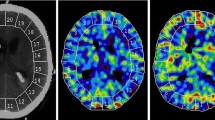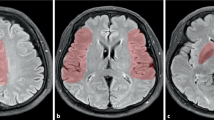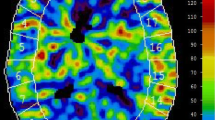Abstract
Early brain injury (EBI) plays a significant role in poor outcomes for subarachnoid hemorrhage (SAH) patients. Further investigations are required to characterize the cellular metabolic and related histological changes that may contribute to EBI following SAH. We investigated the image patterns of 18-fluorodeoxyglucose positron emission tomography-computed tomography (18FDG PET-CT) during EBI and correlated histopathological changes utilizing a rat SAH model. SAH was induced in six adult male Sprague-Dawley rats by endovascular perforation, and animals were randomly assigned to receive 18FDG PET-CT imaging at either 3 or 12 h post-procedure. Mean 18FDG standard uptake value (SUV) of the brain was calculated. Animals were euthanized 48 h post-procedure, and brain samples were used for heme oxygenase-1 (HO-1) and dopamine- and cAMP-regulated phosphoprotein (DARPP-32) Mr 32 kDa immunohistochemistry. Rats within the SAH group had higher mean whole brain 18FDG SUV (2.349 ± 0.376 g/ml in the 3-h group and 2.453 ± 0.495 g/ml in the 12-h group) compared to that of sham (n = 3; mean SUV = 2.030 ± 0.247 g/ml; P < 0.05) or control groups (n = 3; mean SUV = 1.800 ± 0.484 g/ml; P < 0.05). Whole brain 18FDG SUV did not vary significantly between rats imaged at 3 h vs. those imaged at 12 h post-SAH (P > 0.05). Regions of decreasing SUV in SAH rats correlated with neuronal death and increased expression of HO-1. Higher 18FDG PET SUV was evident in rats post-SAH compared to sham and control groups. Regions of decreasing SUV in SAH rats correlated with neuronal death and increased HO-1 expression as evaluated by histopathology.




Similar content being viewed by others
References
Cahill J, Zhang JH. Subarachnoid hemorrhage: is it time for a new direction? Stroke. 2009;40(3 Suppl):S86–7.
Carpenter DA, Grubb Jr RL, Tempel LW, Powers WJ. Cerebral oxygen metabolism after aneurysmal subarachnoid hemorrhage. J Cereb Blood Flow Metab. 1991;11(5):837–44.
Coles JP. Imaging after brain injury. Br J Anaesth. 2007;99(1):49–60.
Dwyer BE, Nishimura RN, De Vellis J, Yoshida T. Heme oxygenase is a heat shock protein and PEST protein in rat astroglial cells. Glia. 1992;5(4):300–5.
Ferro JM, Canhao P, Peralta R. Update on subarachnoid haemorrhage. J Neurol. 2008;255(4):465–79.
Friedrich B, Muller F, Feiler S, Scholler K, Plesnila N. Experimental subarachnoid hemorrhage causes early and long-lasting microarterial constriction and microthrombosis: an in-vivo microscopy study. J Cereb Blood Flow Metab. 2012;32(3):447–55.
Frykholm P, Andersson JL, Langstrom B, Persson L, Enblad P. Haemodynamic and metabolic disturbances in the acute stage of subarachnoid haemorrhage demonstrated by PET. Acta Neurol Scand. 2004;109(1):25–32.
Germano A, d'Avella D, Imperatore C, Caruso G, Tomasello F. Time-course of blood-brain barrier permeability changes after experimental subarachnoid haemorrhage. Acta Neurochir (Wien). 2000;142(5):575–81.
Hayashi T, Suzuki A, Hatazawa J, Kanno I, Shirane R, Yoshimoto T, et al. Cerebral circulation and metabolism in the acute stage of subarachnoid hemorrhage. J Neurosurg. 2000;93(6):1014–8.
Jin H, Xi G, Keep RF, Wu J, Hua Y. DARPP-32 to quantify intracerebral hemorrhage-induced neuronal death in basal ganglia. Transl Stroke Res. 2013;4(1):130–4.
Kuroki M, Kanamaru K, Suzuki H, Waga S, Semba R. Effect of vasospasm on heme oxygenases in a rat model of subarachnoid hemorrhage. Stroke. 1998;29(3):683–9.
Lee JY, Keep RF, He Y, Sagher O, Hua Y, Xi G. Hemoglobin and iron handling in brain after subarachnoid hemorrhage and the effect of deferoxamine on early brain injury. J Cereb Blood Flow Metab. 2010;30(11):1793–803.
Lee JY, Sagher O, Keep R, Hua Y, Xi G. Comparison of experimental rat models of early brain injury after subarachnoid hemorrhage. Neurosurgery. 2009;65(2):331–43.
Nimura T, Weinstein PR, Massa SM, Panter S, Sharp FR. Heme oxygenase-1 (HO-1) protein induction in rat brain following focal ischemia. Brain Res Mol Brain Res. 1996;37(1–2):201–8.
Novak L, Emri M, Balkay L, Szabo S, Rozsa L, Molnar P. [FDG-PET-scan in subarachnoid hemorrhage]. Orv Hetil. 2002;143(21 Suppl 3):1308–10.
Novak L, Emri M, Molnar P, Balkay L, Szabo S, Rozsa L, et al. Regional cerebral (18)FDG uptake during subarachnoid hemorrhage induced vasospasm. Neurol Res. 2006;28(8):864–70.
Okubo S, Strahle J, Keep RF, Hua Y, Xi G. Subarachnoid hemorrhage-induced hydrocephalus in rats. Stroke. 2013;44(2):547–50.
Sehba FA, Pluta RM, Zhang JH. Metamorphosis of subarachnoid hemorrhage research: from delayed vasospasm to early brain injury. Mol Neurobiol. 2011;43(1):27–40.
Sharp FR, Zhan X, Liu DZ. Heat shock proteins in the brain: role of Hsp70, Hsp 27, and HO-1 (Hsp32) and their therapeutic potential. Transl Stroke Res. 2013;4(6):685–92.
Sobrado M, Delgado M, Fernandez-Valle E, Garcia-Garcia L, Torres M, Sanchez-Prieto J, et al. Longitudinal studies of ischemic penumbra by using 18 F-FDG PET and MRI techniques in permanent and transient focal cerebral ischemia in rats. Neuroimage. 2011;57(1):45–54.
Sugawara T, Ayer R, Jadhav V, Zhang JH. A new grading system evaluating bleeding scale in filament perforation subarachnoid hemorrhage rat model. J Neurosci Methods. 2008;167(2):327–34.
Turner CP, Panter SS, Sharp FR. Anti-oxidants prevent focal rat brain injury as assessed by induction of heat shock proteins (HSP70, HO-1/HSP32, HSP47) following subarachnoid injections of lysed blood. Brain Res Mol Brain Res. 1999;65(1):87–102.
van Gijn J, Kerr RS, Rinkel GJ. Subarachnoid haemorrhage. Lancet. 2007;369(9558):306–18.
Xi G, Keep RF, Hua Y, Xiang J, Hoff JT. Attenuation of thrombin-induced brain edema by cerebral thrombin preconditioning. Stroke. 1999;30(6):1247–55.
Yan FHQ, Chen J, Wu C, Gu C, Chen G. Progesterone attenuates early brain injury after subarachnoid hemorrhage in rats. Neurosci Lett. 2013;24(543):163–7.
Zhou Y, Martin RD, Zhang JH. Advances in experimental subarachnoid hemorrhage. Acta Neurochir Suppl. 2011;110(Pt 1):15–21.
Conflict of Interest
The authors have no conflicts of interest to report pertaining to the materials or methods used in this study or the findings specified in this paper.
Author information
Authors and Affiliations
Corresponding author
Rights and permissions
About this article
Cite this article
Song, J., Li, P., Chaudhary, N. et al. Correlating Cerebral 18FDG PET-CT Patterns with Histological Analysis During Early Brain Injury in a Rat Subarachnoid Hemorrhage Model. Transl. Stroke Res. 6, 290–295 (2015). https://doi.org/10.1007/s12975-015-0396-8
Received:
Revised:
Accepted:
Published:
Issue Date:
DOI: https://doi.org/10.1007/s12975-015-0396-8




